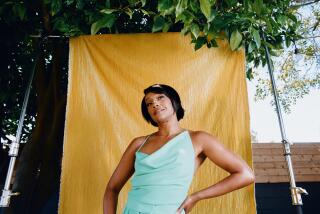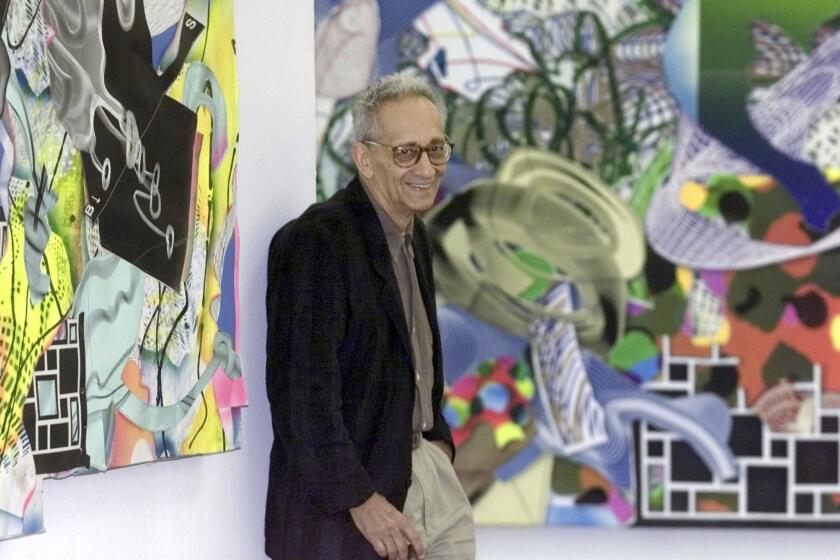ART REVIEW : Dowell’s Visual Essays on Vibrant Living : His painted collages show us how to piece together luxurious experiences from day-to- : day existence. They also reinvigorate abstract art by restoring its moral dimension.
During the past decade, Roy Dowell has been among a number of disparate painters who have worked to reinvigorate and reopen the narrow and rather enervated realm of abstract art. At the Santa Monica Museum of Art, a small, highly focused and almost uniformly outstanding exhibition of Dowell’s recent painted collages offers ample evidence of his extraordinary level of success.
His exhibition inaugurates a new Focus Gallery, designed to house small group or solo shows that, according to the museum’s director, Thomas Rhodes, “highlight innovative advances in the work of an established artist or introduce new works by lesser-known artists,” who have no gallery affiliation. It’s a felicitous debut for the space.
Dowell’s show presents a series of 36 small collages begun during an August, 1991, residency at the Djerassi Foundation near San Francisco, a series completed by August of the following year. All are vertical , and each is 9 by 6 7/8 inches.
The restricted time frame and the regularity of the format together speak of an artist who has chosen to impose an arbitrary order on the otherwise random flow of day-to-day existence. Imagine the Modern tradition of a compositional grid simply reinterpreted as a behavioral mode of operation.
The collages are assembled from random bits of machine-printed paper, often but not always salvaged from the type of advertising posters commonly slathered on urban walls. The visual regularity of these mass-produced posters is slyly echoed in Dowell’s systemic format.
Typically, the bits of paper are cut or torn in such a manner as to obscure their original subject. Screens of multicolored dots, flat geometric shapes, linear scaffoldings, eccentric patterns--these and more collide in Dowell’s work.
Woven through these abstract shapes and gestures are spare threads of recognizable images and letters of the alphabet. Shapes balance atop a pair of prancing feet. Eyes peer out from amid a welter of visual detritus. Pieces of words and bits of letters start to speak, only to be derailed by their fragmentation.
All orders of visual experience can be randomly encountered in the medium of collage, and Dowell vigorously embraces the open-ended diversity. He stitches the cacophonous array together with wit, elan and elegance, transforming the dissonance of the everyday into sensuously atonal reveries.
It isn’t exactly a process of making order out of chaos. It’s more like recognizing a beauty within the muddle, and cranking up the volume.
Dowell does so through a combination of compositional arrangement and the considered addition of painted marks. The swoop of a curving letter might end abruptly in a cut-and-pasted scrap of paper, which acts as a visual lid, only to have its shape echoed in a roughly painted arc that forcibly drags the eye to another, unexpected encounter on the opposite edge of the page.
Dowell performs a kind of juggling act in which Indian clubs, bowling balls, heads of lettuce and assorted kitchen knives keep getting tossed into the mix, while the artist continuously hones his hand-eye coordination in order to keep them all aloft. Rarely does he drop the ball.
Occasional jokes lighten the mood. Most are abstract visual puns, in which wildly different kinds of shapes or patterns surreptitiously mimic one another.
Sometimes, figurative allusions arise. A dense, aggressive array of shapes might find a jagged, off-kilter, multipointed star at its center, as if the visual field had become so compacted that it set off a cartoon-like explosion. Or, a newspaper illustration of a safe, “Federal-State Inspected, For Your Protection,” nestles amid the abstract debris, wryly making fun of the ostensibly hidden meanings locked inside the arcane forms of Modern abstract art.
In Dowell’s art, the meaning isn’t locked away inside. It’s right there on the surface, laid out in the activity of making. Therein lies their crucial quality: Each of these exquisite collages is a concise, intricate little visual essay on how to live--on how to piece together a vibrant, luxurious and continually surprising array of experiences from the gross inundations of life.
The extent of Dowell’s achievement must be measured against the monumentality of his task. The project for a resuscitation of abstraction has been complex, not least because the pedestal on which abstraction has been placed in 20th-Century art is the highest of the high.
In many respects the idea of abstraction came to be virtually synonymous with Modern art; furthermore, it was abstraction that served as the vehicle for the maturation of American painting in the 1950s. Now, to make convincing art in an abstract language means two daunting dilemmas have to be overcome.
On one hand is the simple sense of exhaustion that, perhaps inevitably, accompanied a revolutionary form that has been in continuous, concentrated use since Wassily Kandinsky and Arthur Dove at the century’s start. (In Dowell’s case, the use of abstract collage--once radical, but now routinely taught to kindergarteners--only upped that ante.) What could possibly be left to do?
On the other is the lingering identification of abstract painting with the triumph of Modernism. In a Postmodern world, how could abstraction possibly claim a significant function, except as a winkingly ironic cue to the spectator that its intended meaning was exactly the opposite of abstraction’s usual sense?
The significance of Dowell’s painted collages is that they use highly accomplished abstract means to attain far more than purely formal ends. Without apology and with expansive charm, they manage to restore a moral dimension to abstract art.
* Santa Monica Museum of Art, 2437 Main St., (310) 399-0433, through Sept. 5. Closed Mondays and Tuesdays.
More to Read
The biggest entertainment stories
Get our big stories about Hollywood, film, television, music, arts, culture and more right in your inbox as soon as they publish.
You may occasionally receive promotional content from the Los Angeles Times.







